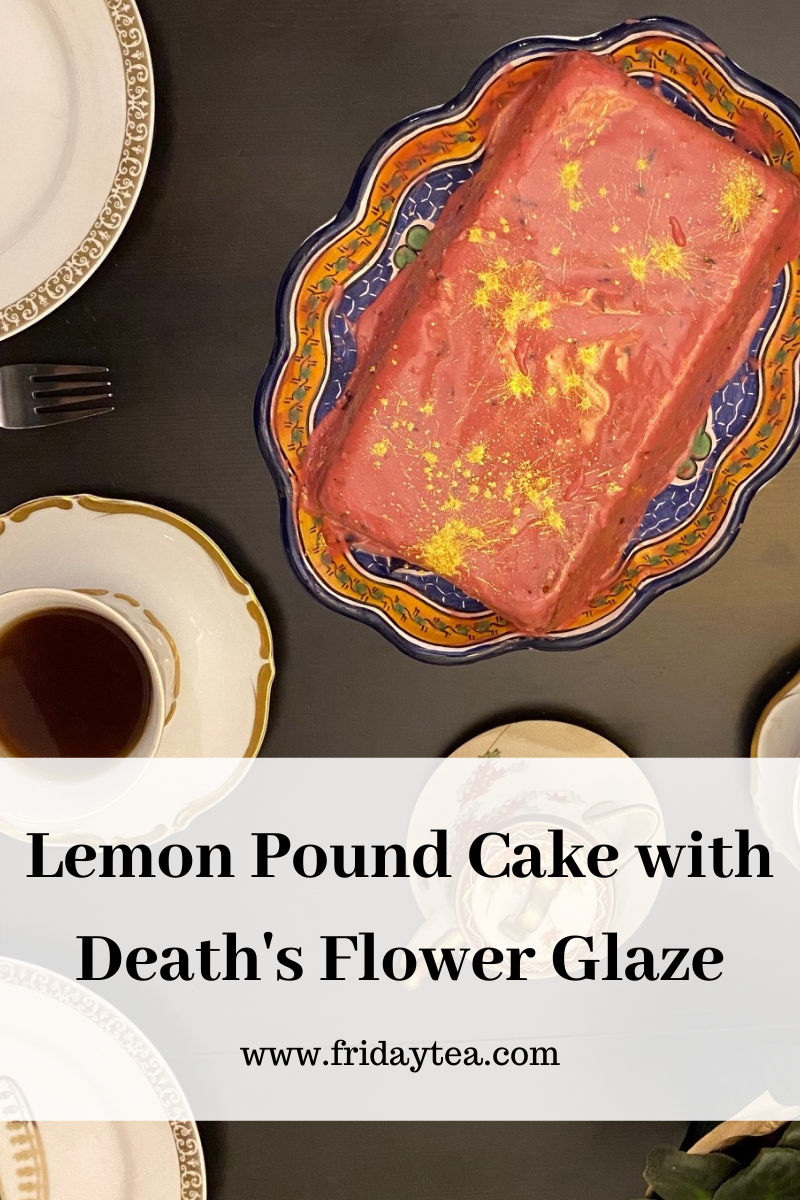Lemon Pound Cake with Death's Flower Glaze
 |
| Death's Flower |
Hello, darlings!
A few months back our house teen, Teacup, designed for us a whole collection of teas inspired by the hit D&D actual play show Critical Role. The blend featured in today's recipe post immediately became a fan favorite, and we drink it frequently in our house as well! Death's Flower is inspired by Caduceus Clay, a kind-hearted and loyal Firbolg cleric. The tea itself is a humusy, rich, dark earthy blend of fifteen year cave aged puerh tea with dry grapefruit peel and perky hibiscus.
Our friend Celeste Conowitch mentioned in passing that this tea would be fantastic in a glaze of some sort, and while she may have meant a savory glaze for roasts (which would also be delicious for sure), I immediately decided we were talking about cake. Because as the tea house's Executive Fae, it's my job to be sure we are always talking about cake. On the spot, in that moment, I promised y'all a lemon pound cake with Death's Flower-infused glaze. I'm here to make good on that claim!
Let us know how you like the recipe below. Happy baking!

Lemon Pound Cake with Death's Flower Glaze
Yield: 8-10
Prep time: 15 MinCook time: 55 MinTotal time: 1 H & 10 M
A bright, classic lemon pound cake is the ideal counterpoint for this dark and earthy aged tea blend.
Ingredients
The Cake
- 1 1/2 cups All-purpose flour (can be gluten-free)
- 1/2 tsp Baking powder
- 1/2 tsp Salt
- 3/4 cup (1.5 sticks) Unsalted butter, softened to room temperature
- 1 cup Granulated sugar
- 3 Large eggs, at room temperature
- 1/4 cup Sour cream, at room temperature
- 3 Tbsp Freshly squeezed lemon juice
- Zest of 1 lemon
- 1 tsp Vanilla extract
The Icing
- 1 cup Confectioner's sugar (powdered sugar)
- 2 Tbsp Strong-brewed Death's Flower tea, cooled
- 1/2 Tbsp Heavy Cream
Instructions
- Preheat oven to 350F and grease a 9x5 inch loaf pan.
- Whisk the flour, baking powder and salt in a large bowl and set aside.
- Beat butter on high in a large bowl until smooth and creamy. Add granulated sugar and cream for about two minutes. Scrape down sides and bottom as needed. Add eggs one at a time on low speed until completely mixed in.
- Add sour cream, lemon juice, lemon zest and vanilla extract to the butter mixture and beat on medium speed until combined, scraping sides and bottom as needed.
- With the beater running on low, slowly add the dry ingredients into the wet. Mix until just combined, running a whisk through as needed to break up any large clumps. Batter will be fairly thick.
- Spread batter into greased pan and bake for 45-60 minutes. Cake is finished when a toothpick inserted in the center comes out mostly clean, with only a few m.oist crumbs.
- Set finished bake on wire rack to cool for about an hour, then run a knife around the edge and gently tip onto a plate for icing. While it continues to cool, prepare the icing.
- ICING: Whisk confectioner's sugar, Death's Flower tea and cream together and pour over the cake. For a thicker glaze, reduce the amount of liquid used. For a thinner, glassier glaze, add more liquid to the mix. This is best done when the cake is still slightly warm, as the icing will permeate the soft top layer of cake more effectively and meld the tea and citrus flavors.
- Cake may be served immediately, but will slice up messy if cut while still warm. For tidier presentation, wait for the cake to completely cool before slicing.
- Cover and store leftovers (if there are any!) for up to three days at room temperature or one week refrigerated.
Notes:
This lemon pound cake recipe was created by Sally's Baking Addiction (sallysbakingaddiction.com). We love her recipe and do not take credit for the cake. It's a perfect vehicle for our original twist: the tea-infused glaze!
Comments
Post a Comment